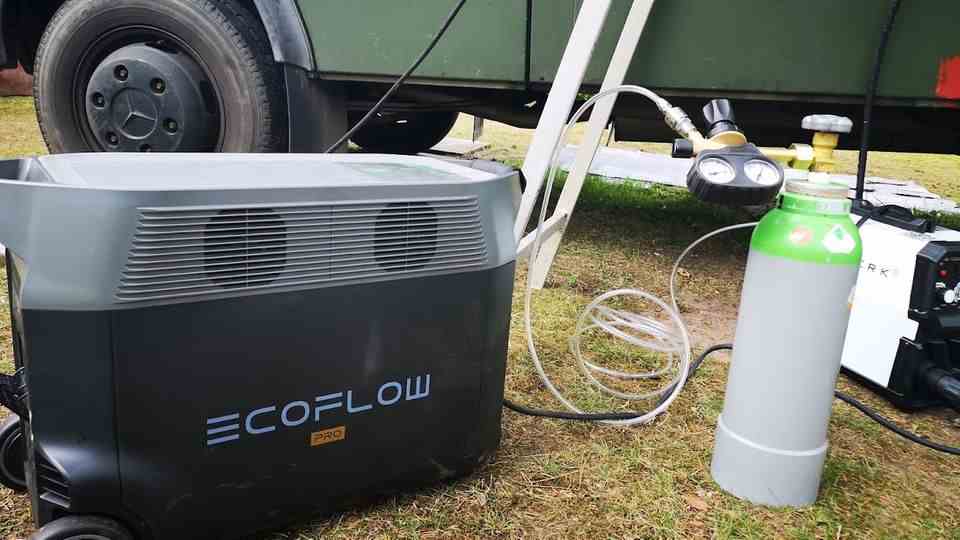Ecoflow power kits
As easy as Lego – complete power supply for campers or tiny houses
The boxes have been given the best place in the car for the press photo, but you can also hide them.
©PR
Ecoflow wants to revolutionize the market for power supply in campers and cabins. With the “Powerkits”, a system for demanding tasks is coming onto the market that can be put together without special knowledge.
Power boxes are a niche market that is growing rapidly. Some want to use it to illuminate their hut, others want to use it to generate electricity for van life and third parties are thinking of saving money with a mobile solar system. There are also houses without electricity, which is rather rare in Germany, but not uncommon in many EU countries. The energy crisis makes the vision of a self-sufficient power supply more exciting.
More than just a box
So far, power boxes have also been offered by Ecoflow as a “box”. The advantage: the customer does not have to worry about anything. He only has to charge it – whether from the grid, the car or the solar panel. And he can tap into the power at the connections of the box. The company’s technicians can think about the inner workings, the customer doesn’t have to. The model reaches its limits when not only a mobile workplace or a tent is to be supplied with electricity, but larger units. Like a weekend cabin, a tiny house or a large mobile home. Systems that not only need one or two wires to the box, but are supposed to supply a whole network of cables, circuits and sockets.
Ecoflow now wants to solve this dilemma. The company has received several awards because its solar systems dissolve the boundaries between stationary and mobile facilities. It is now launching kits with a so-called power hub on the European market. Simply put, here the box is divided into two parts. Once in the battery. The complex electronics migrate to another module, the hub. The hub isn’t there for you to plug in your load, it’s the heart of the power supply from which networks are fed. Key difference: The hub is installed and no longer mobile.
Compact and foolproof
In principle, the boxes and the hub do nothing different than what you can put together yourself from various components. Only here no knowledge is required. No lines are soldered, the parts are connected with standardized plug-in cables. A mobile smart power box, “dumb” batteries or solar panels can be connected to them. The batteries are available with 2000 and 5000 Wh and they can be clustered and stacked on top of each other for higher performance. And of course it is also possible to simply convert the modules. You can usually integrate battery storage and solar cells into a home system and transfer them to the camper for vacation.
The system is based on 48-volt technology, which means that high currents are possible without the cable cross-sections getting fatter. This also helps when increasingly powerful solar modules are installed. The Power Hub delivers a maximum power of 3600 watts. That’s enough to power just about anything that’s equipped with a 230-volt Schuko plug. The only thing you won’t be able to do is start the washing machine and oven at the same time. Several devices are always integrated in the hub: two solar chargers, a DC charger to charge the system from the alternator, an inverter that generates the 230 volt current and a transformer that converts the internal 48 volts to 12 volts -Direct current brings.
Large performance range
The kits come in three tiers – as the connected circuits get larger and more complex, you have to reach for the better equipped sets. At the same time, the three lines will be equipped with accumulators of different strengths. The useful combinations depend on the application. In a small camper, 2000 watt hours of capacity and a solar panel with an output of 400 watts are sufficient. If you want to use it to generate electricity for an entire holiday home, you would have to use more storage and then correspondingly more solar capacity so that the storage can be filled. The range of prices is correspondingly large. The 2000 Wh kit starts at around 5000 euros and goes up to 7350. If you upgrade to 15,000 watt hours – which already corresponds to a solid house system – the prices are between 17,000 and almost 20,000 euros. Each for putting together a complete system. After the market launch, you will probably be able to put together a set yourself, but a bundle usually has a great price advantage over the individual components.
Conclusion
The prices make you swallow at first. But fundamentally, the energy transition is not in vain. The consolation is that the electricity will later be free. In addition, there is no bill for the installation, or it should be much lower. A bundle in the 2000 watt class is sufficient for campers, mobile homes and huts, with which an additional battery can be attached later if required. The downward compatibility with 12-volt technology is exciting. In this way, you retain access to the wide range of consumers and could relatively easily convert an old mobile home with lead-acid batteries to Ecoflow technology including a solar panel. The Ecoflow system simplifies installation, wiring errors should be practically impossible. It remains to be seen whether third-party components can also be integrated without impairing the smartness of the system.




